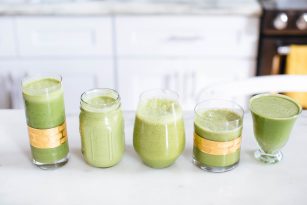The benefits of cauliflower have garnered a good amount of attention lately.
Cauliflower is a vegetable that contains many small florets that makeup one large head. It’s also part of the cruciferous vegetable family (funny name, I know), which also includes veggies like Brussels sprouts, kale, broccoli, cabbage, bok choy, mustard greens, collards, watercress, and radishes. Although it’s most commonly white in color, cauliflower can also be spotted in a variety of other hues, including green, purple, and even orange.
I have to say, cauliflower was one of my least favorite vegetables when I was younger. The only way I would eat this white, flaky, and crumbly vegetable involved grabbing little pieces covered in Italian or French dressing out of my parents’ salad bowls. As I’ve grown older, I think I’ve learned to appreciate and love every vegetable I’ve come across, including cauliflower.
Cauliflower has several unique culinary qualities to it which allows a variety of uses. Have you ever thought of making mashed “potatoes”, rice, bread, muffins, pizza crust or even dessert out of a vegetable? No? Well this vegetable may now be your favorite, especially for any of you living a low-carb, paleo lifestyle, or trying to fit specific macronutrients in your diet.
Cauliflower Nutrition Facts
Cauliflower is a great source of several important vitamins and minerals. Each serving is low in cauliflower calories, yet loaded with vitamin C, vitamin K, and many B-vitamins.
One cup of raw cauliflower contains these key nutrients (1):
- 25 calories
- Carbohydrates: 5.3 grams
- Protein: 2 grams
- Fiber: 2.5 grams
- Vitamin C: 77% of the DV
- Vitamin K: 20% of the DV
- Folate: 14% of the DV
- Vitamin B6: 11% of the DV
- Potassium: 9% of the DV
- Manganese: 8% of the DV
- Pantothenic acid: 7% of the DV
- Magnesium: 4% of the DV
- Phosphorus: 4% of the DV
- Thiamine: 4% of the DV
- Riboflavin: 4% of the DV
- Niacin: 3% of the DV
- Zinc: 2% of the DV
- Copper: 2% of the DV
- Calcium: 2% of the DV
- Iron: 2% of the DV
Cauliflower also contains a small amount of selenium, along with a mix of both omega-3 and omega-6 fatty acids.
Health Benefits of Cauliflower Nutrition
1. High in antioxidants
Antioxidants are powerful compounds that can help neutralize harmful free radicals to support better health. Some research shows that antioxidants could play an integral role in health and disease and may offer protection against conditions like autoimmune disease disease, obesity, diabetes, heart problems, and cancer (2). Antioxidants may also help reduce inflammation, which can be especially beneficial for autoimmune disorders like rheumatoid arthritis, lupus, and inflammatory bowel disease.
The cauliflower nutrition profile is loaded with antioxidants, including beta-carotene, cinnamic acid, ferulic acid, kaempferol, beta-cryptoxanthin, caffeic acid, quercetin, and rutin.
2. Promotes detoxification
Cruciferous vegetables like cauliflower contain several beneficial compounds such as glucosinolates, which can help promote natural detoxification in the body. These compounds are thought to increase levels of specific enzymes used by the liver to metabolize and detoxify drugs and chemicals (3). Some studies have also found that sulforaphane, another compound found in cruciferous veggies, can improve liver function to help it work efficiently (4).
3. May aid in cancer protection
Promising research has found that cauliflower could help block the growth and spread of cancer cells. One study published in the journal Pharmacology Research noted that sulforaphane and indole-3-carbinol (I3C), both of which are found in cauliflower, have been well-studied for their potent anti-cancer properties (5). In fact, studies also show that eating more cruciferous veggies could be tied to a lower risk of lung, breast, ovarian, and stomach cancer (6, 7, 8, 9).
Keep in mind that these studies show an association but don’t necessarily take other factors into account that could play a role in cancer development. Therefore, additional studies are needed to examine the relationship between cauliflower—and other cruciferous veggies—and the risk of cancer.
4. Prevents bacterial growth
Interestingly enough, some research shows that some compounds found in cauliflower could help protect against certain types of harmful bacteria. For example, one study reported that sulforaphane, which is found in cauliflower and other cruciferous veggies, was able to effectively block the growth of Helicobacter pylori (10). This specific strain of bacteria is typically found in the stomach, and can cause stomach ulcers to develop over time.
5. Great source of fiber
Besides providing a wealth of vitamins, minerals, and antioxidants, cauliflower is also rich in fiber. Fiber is an important nutrient that passes through the gastrointestinal tract undigested, pushing materials through the intestines to help promote regularity. Not only can upping your intake of fiber prevent constipation and ease bowel movements, but it may also improve several other aspects of digestive health as well. In particular, fiber is thought to help prevent stomach ulcers, hemorrhoids, diverticulitis, and gastroesophageal reflux disease (GERD).
Fiber can also stabilize blood sugar levels by slowing the absorption of sugar in the bloodstream. It may even be linked to a lower risk of heart disease, stroke, diabetes, and obesity. Plus, it could potentially help lower cholesterol levels and blood pressure to boost heart health (11).
Easy Ways to Prepare Cauliflower
- Enjoy it raw as a snack, along with hummus, guacamole, salsa, or your other favorite dips
- Eat it steamed for a simple side dish to your main meal
- Puree it to use as a “bed” to add toppings onto
- Chop it into florets and add to a salad
- Try roasting it with turmeric and coconut oil, one of my favorites
- Steam it and “mash” it
- Use it to bump up the nutritional value of your favorite soups
If possible, try to consume cauliflower either in it’s raw state or lightly steamed, which results in the least nutrient loss via cooking and helps maximize the cauliflower nutrition profile. This is especially important to help retain vitamin C and glucosinolates, which are important nutrients that are more sensitive to nutrient loss via cooking.
Cauliflower Recipes
Need some ideas for how to prepare this versatile veggie? Here are a few of my favorite recipes to take advantage of the nutritional value of cauliflower:
- The Best Cauliflower Salad
- Creamy Cauliflower Spinach
- BBQ Cauliflower Bites
- Cauliflower Pizza Crust
- Tahini Miso Covered Cauliflower Steaks
How to Shop and Store Cauliflower
You can easily find cauliflower at most major grocery stores in the produce department. When purchasing cauliflower, be sure to select fresh, organic varieties as often as possible. This can minimize your exposure to harmful pesticides and ensure you’re getting the most cauliflower nutrition possible. Look for an even white color free of mold, brown spots, or any soft areas. Florets should also be fully intact and hard to the touch. Additionally, be sure to choose heads that have more thick green leaves, as this may help better protect cauliflower from going bad.
Proper storage is key for extending the shelf-life of your cauliflower. Simply store sealed in a ziplock bag in your refrigerator after using. Typically, cauliflower can last 3-4 days before it spoils, depending on the settings of your refrigerator.
How to Make the Most out of The Benefits of Cauliflower
Cauliflower is a delicious and versatile vegetable that makes a great addition to a well-rounded diet. Not only does it boast a pretty impressive cauliflower nutrition profile, but it’s also associated with several health benefits and can be used in a number of different recipes.
If you’re looking for more support and ways to integrate cauliflower and other nutritious plant-based whole foods into your daily diet, sign up for my Foundational Five: Eating Well Made Easy course to learn exactly what to put on your plate at each meal.








